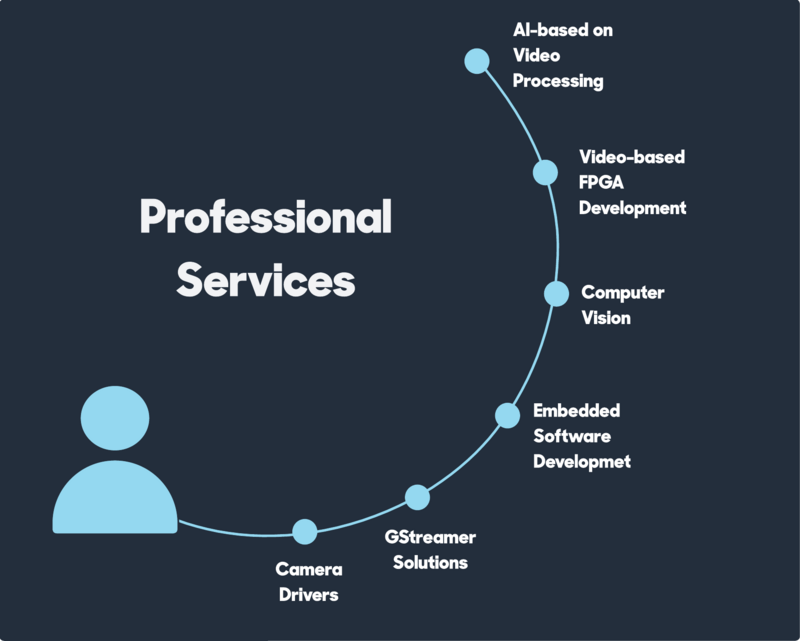RidgeRun Linux Camera Drivers - Introduction
An Introduction to Linux Camera Drivers
A Linux driver is a specialized software that bridges the communication gap between the Linux operating system and specific hardware. It enables the operating system to comprehend and interact with the hardware device.
The driver facilitates communication by providing a means for the kernel, the core of the operating system, to send instructions to the hardware and receive data in return. It abstracts the complexity of the hardware, hiding its details from the operating system and user applications. This abstraction allows applications to interact with the hardware in a standardized manner, irrespective of the device model. Additionally, the driver exposes the hardware's functionalities to the operating system, enabling applications to leverage the full capabilities of the device.
Popular Camera Sensors
Raspberry Pi Camera Module 3 IMX708
The Raspberry Pi Camera Module 3 features a Sony IMX708 sensor with an 11.9-megapixel resolution. RidgeRun has developed a V4L2 driver for this camera module, enabling it to work with Jetson Nano and Jetson Orin Nano platforms. The driver currently supports 4608 x 2592 @ 14fps resolution. If you need additional modes, RidgeRun can develop them upon request. For more information about this specific driver, check this wiki page.
Raspberry Pi HQ camera IMX477 Linux driver for Jetson
The Raspberry Pi HQ Camera features a 12.3-megapixel Sony IMX477 sensor. It uses a back-illuminated sensor architecture for enhanced sensitivity and supports different C- and CS-mount lenses. The camera also includes an integrated back-focus adjustment ring and tripod mount.
RidgeRun has developed a V4L2 driver for the IMX477 sensor, making it compatible with Jetson Xavier NX and Jetson Nano platforms. The driver currently supports several modes, including full (4:3) and 16:9 resolutions at different frame rates. If you need additional modes or have other Jetson platforms, RidgeRun can provide further information and support.
For detailed instructions on patching JetPack sources and enabling the IMX477 sensor driver, you can refer to RidgeRun’s dedicated IMX477 wiki page.
Sony IMX219 Linux driver
The Sony IMX219 is a CMOS image sensor with features like CSI2 serial data output, various frame rates, and a max resolution of 3280 x 2464 pixels. RidgeRun has developed a driver for the Jetson TX1 platform, supporting resolutions up to 1080p and tested with Auvidea boards. If you want to use this driver, follow the instructions provided by RidgeRun in this link.
GeoSemi GW5300 ISP V4L2 Linux driver
The GeoSemi GW5300 is an advanced Automotive Camera Video Processor System-on-Chip (SoC) with integrated camera system capabilities. RidgeRun, actively develops V4L2 drivers for this SoC. Our expertise lies in creating custom Linux V4L2 drivers for embedded systems, including camera sensors and chips.
The GW5300 features an eWARP Geometric Processor for lens distortion correction, an HDR Signal Processor for high dynamic range imaging, and an Overlay Graphics Engine for 2D-Vector Graphics Acceleration. It supports various resolutions and input formats through MIPI and Parallel I/O interfaces, and communicates via a command API for stand-alone operation and modular driver design. If you need further information, feel free to check this wiki!
Toshiba TC358743 Linux driver for Jetson
The Toshiba TC358743 is an HDMI 1.4 to MIPI CSI-2 1.01 bridge chip capable of handling video data up to 1080P at 60 fps. It serves as a critical component for interfacing HDMI devices with NVIDIA Jetson platforms, including the Jetson TX1, TX2, Nano, and Xavier.
RidgeRun, as a leading provider of embedded Linux solutions, we have developed and maintain the Linux driver for the TC358743 on Jetson devices. Our expertise ensures seamless integration and optimal performance. To enable the driver, follow the provided build instructions in this page.
Once the driver is active, you can test it using GStreamer pipelines. RidgeRun’s commitment to quality and support makes us a trusted partner for camera sensor drivers on Jetson platforms.
RidgeRun Driver Development Services
RidgeRun has more than 12 years of experience creating custom Linux V4L2 drivers for embedded systems. The customer selects the hardware sensor or chip and RidgeRun creates the V4L2 driver for it. This wiki describes the services provided by RidgeRun to create a V4L2 driver for your system as well as some of the considerations related to time frame, documentation, hardware, etc. Contact Us section provides info on how to reach the RidgeRun team.
Exclusive Services and Custom Features by RidgeRun
RidgeRun, LLC is an embedded Linux product and service business founded in 2006. We are a high-touch company with +75 engineers focused on reducing our customer's time-to-market and product quality. We specialize in streaming media products and applications and are experts in GStreamer based on technology. RidgeRun's focus is to provide the software infrastructure for custom hardware designs and streaming media based product development.

We have products and services to handle all components of the product development life-cycle. RidgeRun has a long history of helping our customers build successful, enduring product lines across a range of system-on-chips hardware platforms. RidgeRun's services include the following:
- Embedded Linux camera sensor, ISP and peripheral drivers.
- GStreamer-based video and audio software solutions.
- Embedded application / product software development.
- Computer vision
- Video-based FPGA development
- Artificial Intelligence based on video processing.

